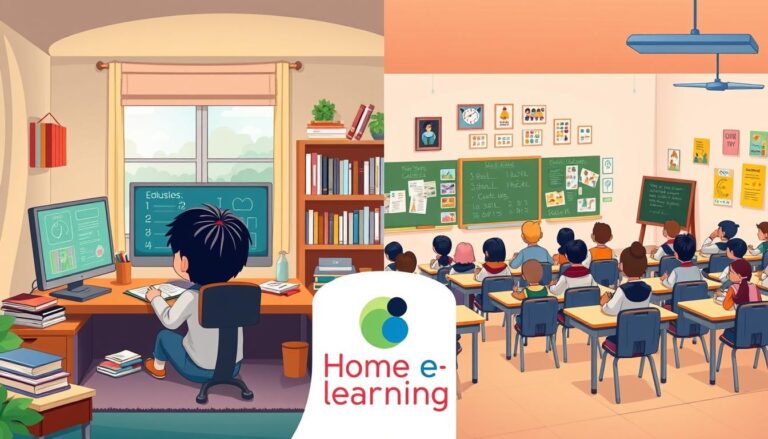Top 10 Educational Apps for Online K-12 Students
Have you ever wondered how digital tools are reshaping the way students learn today? In a world where time and space are no longer barriers, innovative solutions are transforming the classroom experience. These tools are not just about convenience; they’re about creating meaningful connections and improving learning outcomes.
From platforms like Google Classroom to Zoom, technology is bridging gaps and making education more accessible. These tools offer interactive features that engage students and make learning more dynamic. Whether it’s solving math problems or exploring new subjects, the right app can make all the difference.
In this article, we’ll explore the top 10 tools designed specifically for K-12 students. Each one has been carefully selected for its user-friendly design and ability to enhance the learning process. Let’s dive in and discover how these solutions are shaping the future of education.
Introduction to Digital Learning and Educational Apps
The way students engage with learning has transformed dramatically in recent years. Digital tools are now at the forefront of this change, reshaping how we approach education. These tools are not just about convenience; they’re about creating meaningful connections and improving outcomes.
Understanding the Virtual Classroom Landscape
Virtual classrooms have evolved from simple video calls to interactive spaces filled with dynamic content. Teachers and students are now engaging more readily with digital tools, making the learning process more collaborative. Platforms like Google Classroom have become essential for managing assignments and fostering communication.
One of the key benefits is the ease of accessing course materials. Students can now review lessons, submit assignments, and interact with peers from anywhere. This flexibility has made education more accessible, especially for those who face geographical or time constraints.
Why Apps Are Revolutionizing K-12 Education
Digital apps are modernizing traditional learning methods by introducing interactive features. These tools encourage active participation, which has been linked to increased academic success. For example, platforms that integrate quizzes and real-time feedback keep students engaged and motivated.
Teachers also benefit from these innovations. They can track progress, provide personalized feedback, and adapt lessons to meet individual needs. This level of customization was harder to achieve in traditional settings.
As we continue to embrace these tools, the future of education looks brighter and more inclusive. Digital learning is not just a trend; it’s a powerful shift that’s here to stay.
Understanding the Shift to E-Learning in India
India’s education system is undergoing a digital revolution, reshaping how students access knowledge. The adoption of e-learning tools has been accelerated by both cultural and technological factors. This shift is not just about convenience; it’s about making quality education accessible to every user, regardless of location.
One of the key drivers of this change is the increasing use of the web. Platforms like Byju’s and Vedantu have made it easier for students to access curriculum content from the comfort of their homes. These tools are designed to be user-friendly, ensuring that even those with limited computer skills can navigate them effectively.
Parents play a crucial role in this transition. Their involvement helps students stay motivated and engaged with digital learning. Many platforms now offer features that allow parents to track progress and provide support, making the learning process more collaborative.
Cultural and Technological Impacts
Cultural shifts have also contributed to the rise of e-learning in India. Traditional methods are being replaced by interactive tools that cater to diverse learning styles. For example, platforms like Doubtnut use video solutions to help students understand complex math problems quickly.
Technological advancements have further enhanced this experience. The use of augmented reality (AR) and interactive quizzes has made learning more engaging. These innovations are not just improving retention but also making education more inclusive.
Despite these advancements, challenges remain. Access to reliable internet and computers can be a barrier in rural areas. However, the growing demand for quality information is driving efforts to bridge this gap, ensuring that every student can benefit from the digital revolution.
Features That Enhance Learning Experience
Modern learning platforms are designed to keep students hooked with interactive features. These tools are not just about delivering content; they’re about creating an engaging and personalized experience. From responsive layouts to real-time notifications, every feature is crafted to make learning more accessible and enjoyable.
User-Centric Design and Responsive Layouts
A user-centric interface is at the heart of effective digital tools. Platforms that prioritize intuitive navigation ensure that students can focus on learning, not figuring out how to use the app. Responsive layouts take this a step further by making the experience seamless across devices.
Whether accessed on a smartphone, tablet, or desktop, these designs adapt effortlessly. This flexibility ensures that students can learn anytime, anywhere. It’s a feature that truly enhances accessibility and convenience.
Interactive Content and Real-Time Engagement
Interactive elements like video tutorials and quizzes keep students engaged. These features make learning fun and dynamic, turning complex topics into manageable lessons. Real-time notifications and push messages further boost interaction by keeping users informed and motivated.
For example, platforms that integrate live quizzes or instant feedback create a sense of accomplishment. This not only enhances the learning experience but also encourages students to stay consistent. Such tools are transforming the way we approach education, making it more interactive and enjoyable.
Top Educational Apps: Curation Process and Selection Criteria
Selecting the right tools for learning requires a careful and structured approach. We follow a rigorous method to ensure that only the most effective solutions are recommended. Our process involves evaluating usability, features, and the overall learning experience.
Evaluating App Features and Usability
Our first step is to assess the ease of use. A tool must have an intuitive interface that allows students to focus on their lessons without distractions. We also look for interactivity, as engaging activities can significantly enhance the learning process.
Access to quality materials is another critical factor. Whether it’s a course or a study aid, the content must be well-structured and easy to understand. We prioritize tools that offer a variety of resources, from video tutorials to interactive quizzes.
Assessments play a key role in measuring progress. Tools with built-in tests and real-time feedback help students track their performance. This feature ensures that learning is not just about consuming material but also about applying knowledge effectively.
Finally, we consider how lessons and courses are integrated into the tool. A seamless experience that combines study aids with practical activities keeps students motivated. By focusing on these criteria, we ensure that our recommendations are both impactful and reliable.
Google Classroom and Its Role in Virtual Classrooms
Google Classroom has become a vital tool in modern education, simplifying how teachers and students connect. This platform is designed to streamline daily activities, making it easier to manage assignments, track progress, and share resources. Its seamless integration with other Google Workspace tools ensures a smooth and efficient experience for users.
Seamless Integration with Daily Activities
Google Classroom integrates effortlessly with tools like Google Docs, Sheets, and Slides. This allows teachers to create and distribute assignments electronically. Students can submit their work directly through the platform, and teachers can provide real-time feedback. This automation saves time and enhances organization.
One of the key benefits is its ability to track student progress. Teachers can monitor assignments, grades, and participation all in one place. This feature helps identify areas where students may need additional support. It also ensures that everyone stays on the same page, fostering a collaborative learning environment.
Here’s how Google Classroom enhances daily classroom activities:
- Automates assignment submissions and grading.
- Provides secure storage for documents and resources.
- Facilitates communication between teachers and students.
- Offers tools for planning and sharing lessons effectively.
Teachers can also use the platform to plan lessons and share materials with ease. Its user-friendly design ensures that even those new to digital tools can navigate it without difficulty. This makes it a cornerstone platform for managing virtual classrooms.
Globally, Google Classroom has seen high adoption rates due to its efficiency and accessibility. It supports real-time feedback, which is crucial for student growth. By integrating seamlessly into daily routines, it has become an essential tool for educators worldwide.
Kahoot, Zoom, and Other Innovative Learning Tools
Innovative tools like Kahoot and Zoom are transforming how students interact with lessons. These platforms are not just about delivering content; they’re about creating engaging and interactive experiences. By integrating game-based strategies and real-time communication, they’re reshaping the way students learn and collaborate.
Gamification and Engagement Strategies
Gamification is a powerful way to make learning enjoyable. Platforms like Kahoot use game mechanics, such as quizzes and challenges, to keep students motivated. These interactive strategies encourage active participation, which has been linked to better retention and understanding.
For example, Kahoot’s quiz games turn assessments into fun activities. Students can compete with peers while reviewing material, making study sessions more dynamic. This approach not only boosts engagement but also helps teachers track progress in real time.
Real-Time Collaboration and Communication
Real-time collaboration is another key feature of modern tools. Zoom’s breakout rooms allow students to work in small groups, fostering teamwork and communication. This feature is particularly useful for discussions and group projects, as it mimics the in-person classroom experience.
These tools also support immediate feedback. Teachers can assess student responses during live sessions and provide guidance instantly. This helps students stay on track and reinforces their learning.
By combining gamification and real-time communication, these platforms create a dynamic and interactive environment. They encourage note-taking, sustained study habits, and active participation, making learning both effective and enjoyable.
Review of Student-Focused Apps for Interactive Learning
Interactive learning tools are changing how kids engage with lessons. These platforms are designed to make learning more hands-on and fun, helping students grasp complex concepts with ease. By combining video tutorials and practical exercises, they create an environment where kids can thrive.
Apps like Seesaw and Photomath are leading the way in this space. Seesaw allows kids to showcase their work through photos, videos, and drawings, making lessons more interactive. Photomath, on the other hand, uses step-by-step video explanations to simplify math problems, ensuring kids understand each concept thoroughly.
Hands-On Practice and Video Tutorials
Hands-on practice is a key feature of these tools. Kids can solve problems, complete assignments, and receive instant feedback. This approach not only reinforces lessons but also builds confidence in their abilities. Video tutorials further enhance the experience by breaking down complex topics into manageable steps.
Here’s how these apps benefit kids:
- Engage students with fun, interactive tasks.
- Clarify lessons through detailed video explanations.
- Encourage active participation and consistent practice.
- Provide a user-friendly interface for easy navigation.
For example, Photomath’s video tutorials make math less intimidating by showing kids how to solve problems step-by-step. Seesaw’s creative tools allow students to express their understanding in unique ways, making learning more enjoyable.
These platforms also emphasize the importance of a student-friendly design. Intuitive interfaces ensure that kids can focus on learning without getting overwhelmed. Interactive modules keep them engaged, turning lessons into a fun and rewarding experience.
By integrating these tools into their routine, kids can solidify their understanding of lessons while having fun. To explore more about how such platforms are transforming education, check out this resource.
Discovering the Best Educational Apps Online School
Finding the right tool for your classroom can make a world of difference in student engagement. With so many options available, it’s essential to evaluate each platform based on your specific needs. We’ll guide you through the process of selecting the ideal solution for your class.
How to Choose the Right App for Your Classroom
Start by considering how well the platform aligns with your curriculum. A tool that integrates seamlessly with your lesson plans ensures a smoother teaching experience. Look for features that offer a variety of activities, from quizzes to interactive modules, to keep students engaged.
Here are some actionable tips to help you make an informed decision:
- Evaluate the quality of content and its relevance to your curriculum.
- Test the user interface to ensure it’s intuitive for both teachers and students.
- Check for features like real-time feedback and progress tracking.
- Create a shortlist of essential features that work best in your class.
Matching app functionalities with your teaching style is crucial. For example, platforms like Prodigy Math and CK-12 offer diverse resources that cater to different learning objectives. These tools provide a mix of video tutorials and hands-on practice, making lessons more dynamic.
Finally, consider the idea of user engagement. A platform that encourages active participation can significantly enhance the learning experience. By focusing on these factors, you’ll find a solution that not only meets your needs but also inspires your students to learn.
Teacher and Parent Perspectives on Digital Learning
Digital learning has brought teachers and parents closer in supporting student success. With the rise of virtual classrooms, both groups are finding new ways to collaborate and enhance the learning experience. Tools like ClassDojo are bridging the gap, making communication smoother and more effective.
Enhancing Communication and Feedback
One of the biggest advantages of digital tools is the ability to provide clear and consistent feedback. Teachers can share updates on assignments, tests, and student progress in real time. Parents, in turn, can stay informed and actively participate in their child’s education.
For example, ClassDojo allows teachers to send messages, share photos, and even celebrate student achievements. This transparency builds trust and fosters a stronger partnership between educators and families. Parents can also use these platforms to monitor their child’s progress and ensure they’re staying on track.
Teachers benefit from streamlined note-taking and assessment processes. Digital tools make it easier to track student performance and identify areas for improvement. This data-driven approach helps tailor lessons to meet individual needs, ensuring no student is left behind.
Here’s a summary of how digital tools benefit both teachers and parents:
| Benefit | For Teachers | For Parents |
|---|---|---|
| Communication | Share updates and feedback instantly | Stay informed about their child’s progress |
| Engagement | Create interactive lessons and tests | Participate in their child’s learning journey |
| Monitoring | Track student performance and note areas for improvement | Ensure their child is meeting academic goals |
Parental involvement is crucial in ensuring digital safety and fostering a positive learning environment. By working together, teachers and parents can create a collaborative virtual environment that supports student success. This partnership is key to achieving better academic outcomes and preparing students for the future.
Integrating Apps with Traditional K-12 Curriculum
Blending modern tools with traditional methods is reshaping K-12 education. This approach combines the strengths of both worlds, offering a balanced and effective learning experience. By integrating digital tools into established curricula, schools can enhance engagement and improve outcomes.
One of the key benefits of this integration is the ability to align app functionalities with existing course material. For example, tools like Google Classroom can complement traditional lessons by providing interactive assignments and real-time feedback. This ensures that students stay engaged while mastering essential concepts.
Here are practical steps to plan a hybrid curriculum:
- Identify core objectives and align digital tools to support them.
- Use apps to supplement traditional teaching methods, not replace them.
- Train teachers to effectively integrate technology into their lesson plans.
- Regularly review and update course materials to keep them relevant.
Thoughtful integration can enrich lesson plans and improve academic outcomes. For instance, schools that have adopted blended learning report higher student engagement and better performance. This approach also allows for personalized learning, catering to individual student needs.
Successful case studies highlight the impact of this integration. For example, a school in India saw a 30% increase in student performance after introducing digital tools into their curriculum. Teachers reported that students were more motivated and actively participated in lessons.
Regular review is essential to ensure that course materials remain current and relevant. By combining modern apps with conventional teaching methods, we can create a more balanced and effective education system. This approach not only prepares students for the future but also ensures they receive a well-rounded education.
Tips for Maximizing the Learning Experience Through Apps
Maximizing the potential of digital tools in education requires strategic planning and thoughtful implementation. By leveraging built-in features and tailoring activities to student needs, educators can create a more engaging and effective learning environment. Here’s how to make the most of these tools.
Tracking Progress and Setting Milestones
Monitoring student progress is essential for identifying strengths and areas for improvement. Many tools offer analytics that provide insights into performance. Use these features to track completion rates, quiz scores, and time spent on modules.
Setting milestones can motivate students to stay consistent. For example, breaking down goals into weekly or monthly targets helps maintain focus. This approach encourages steady progress and builds a sense of accomplishment.
Implementing Engaging Challenges and Quizzes
Interactive quizzes are a powerful way to reinforce concepts and assess understanding. Platforms that offer customizable quizze options allow educators to tailor assessments to specific topics. This ensures that students grasp key ideas effectively.
Math challenges can be particularly impactful. Design exercises that align with curricular goals and cater to different skill levels. This not only enhances learning but also makes math more approachable.
Here’s a summary of strategies to maximize learning experiences:
| Strategy | Implementation |
|---|---|
| Track Progress | Use app analytics to monitor performance and identify trends. |
| Set Milestones | Break goals into weekly or monthly targets to maintain motivation. |
| Engage with Quizzes | Create interactive quizze to reinforce concepts and assess understanding. |
| Tailor Math Challenges | Design exercises that align with curricular goals and skill levels. |
Regular feedback is crucial for student growth. Use adaptive assessments to provide personalized guidance. This ensures that each student receives the support they need to succeed.
By implementing these strategies, educators can create a dynamic and effective learning environment. Thoughtful use of digital tools not only enhances engagement but also fosters long-term academic success.
Innovative Features: Video, Quiz, and Interactive Content
The integration of video and interactive content is transforming how students engage with lessons. These cutting-edge features make learning more dynamic and personalized, ensuring that every student can thrive at their own pace. By combining multimedia elements with adaptive assessments, modern tools are creating immersive and effective learning environments.
Multimedia Integration for Richer Lessons
Video lessons are a game-changer in digital learning. Platforms like Educreations and BookWidgets use rich video content to explain complex topics in an engaging way. These tools allow students to pause, rewind, and revisit lessons, ensuring they grasp every concept at their own level.
Interactive quizzes further enhance the experience. By merging video tutorials with dynamic quizzes, these platforms keep students engaged and motivated. For example, Nearpod’s interactive lessons include polls and activities that encourage active participation.
Adaptive Assessments and Personalized Feedback
Adaptive assessments tailor learning experiences based on a student’s skill level. Tools like Dreambox and Knewton adjust the difficulty of questions in real time, ensuring that each student is challenged appropriately. This approach helps identify strengths and areas for improvement.
Personalized feedback is another key feature. Platforms like Kahoot provide instant feedback on quiz responses, helping students understand their mistakes and learn from them. This immediate reinforcement supports skill development and boosts confidence.
Here’s how these features enhance learning:
- Video lessons make complex topics easier to understand.
- Interactive quizzes keep students engaged and motivated.
- Adaptive assessments ensure lessons match each student’s level.
- Personalized feedback supports individual skill growth.
These innovative features are revolutionizing traditional teaching methods. By integrating video, quizzes, and adaptive assessments, educators can create a more immersive and effective learning environment. For more insights on leveraging these tools, explore this resource.
Conclusion
The future of learning is being shaped by innovative tools that bridge gaps and inspire creativity. Throughout this article, we’ve explored how digital platforms are transforming K-12 education, making it more engaging and accessible for students and teachers alike.
From interactive quizzes to real-time collaboration, these tools are redefining the classroom experience. They empower students to learn at their own pace while providing teachers with valuable insights to tailor lessons effectively. The integration of technology with traditional teaching methods ensures a holistic approach to education.
We are committed to sharing useful ideas and resources that support this transformation. We encourage educators, parents, and students to explore the platforms and tools discussed here. By adopting these methods, you can create a more dynamic and effective learning environment.
Let’s continue this conversation. Share your experiences and feedback on how these tools can be implemented in everyday learning. Together, we can shape a brighter future for education.







